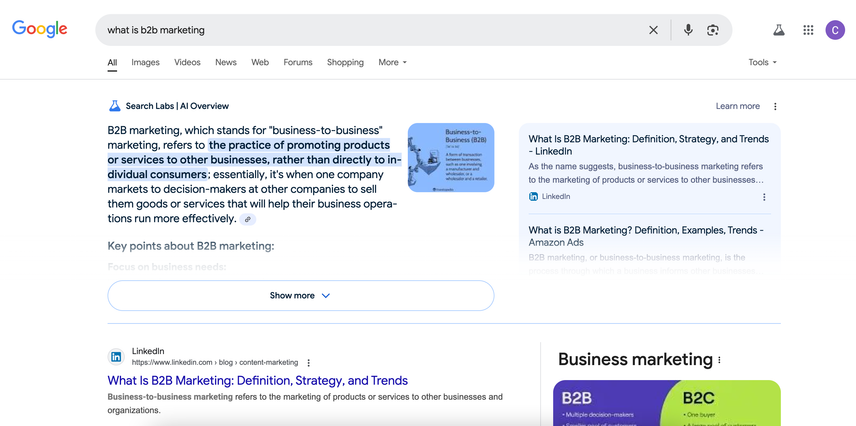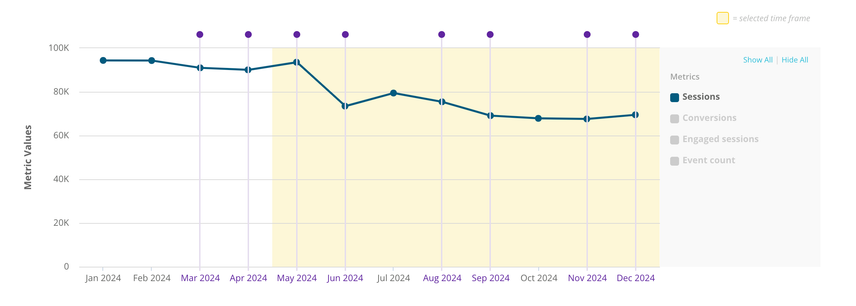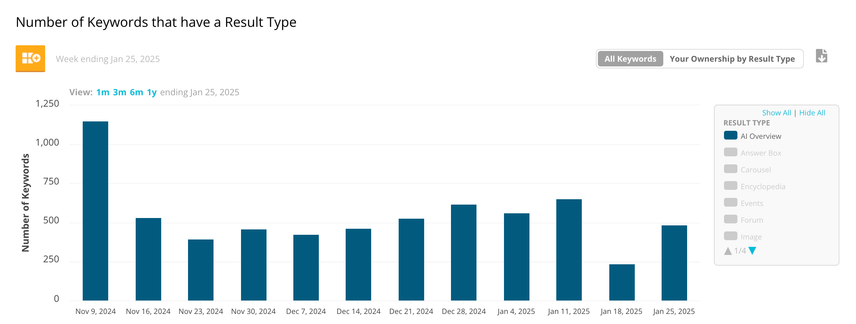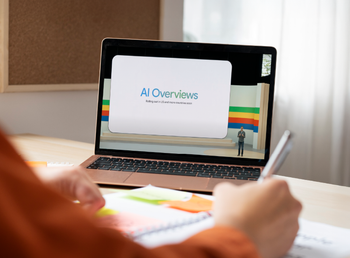The Impact of Google’s AI Overviews on Organic Traffic and How to Respond
- Thought Leadership
- By multiple authors
- 8 minutes read
We've analyzed the impact of AI Overviews and developed strategies to help you prepare your content and site for this new search experience.
When the SEO industry saw Google’s rushed release of SGE, which was later renamed “AI Overviews,” many didn’t expect much of an impact. Fast-forward seven months, and sites are seeing the true impact of Google’s AI overviews. For some, it’s massive and worrying.
Sites with a lot of informational content are seeing significant dips in organic traffic. Search volume has remained steady, but with these oversized, AI-powered next-generation Featured Snippets, Google’s generating even more so-called “zero-click searches.”
In this article, we’ll explain what happened exactly, how it’s impacted Conductor, and what we can do to future-proof our SEO strategy (as well as our digital marketing strategy).
A refresher on AI Overviews
AI Overviews is a Google Search feature that uses AI to break down information from multiple sources in Google’s index into a concise summary. Overviews appear in a box at the top of SERPs, above both paid and organic results, often accompanied by a sidebar with more resources.

AIO results still pull information from SERP content, so appearing in these results is another form of brand awareness.
Keep in mind that AIO results don’t appear for every search. Also, there’s currently no way to know for sure what terms AIO results will appear for or how to capture them when they do appear.
The impact AI Overviews have had on us
AI overviews rearranging the SERP-impacted traffic and conversions (but not in the way you’re probably thinking). AI Overviews now dominate the space above the fold on SERPs for informational queries, and even results referenced in an overview are briefly summarized, leading to zero-click searches and much less traffic.

We looked into the impact that AI Overviews have had on our own site. As you can see, site sessions—AKA traffic—fell significantly in May of 2024, coinciding with Google’s full AIO rollout. In fact, we saw organic traffic drops as large as 60% on some of our pages. Since then, despite some slight increases over the summer, traffic has settled in at roughly 25% fewer sessions month-over-month.
That said, it’s fair to wonder how much of that traffic was converting in the first place because conversions, in contrast to sessions, have only fallen slightly.
From there, we looked into our tracked keywords to understand how often AIO results were appearing for key terms. As you can see, there’s some fluctuation in the frequency that overviews appear, which is to be expected given all the tweaking Google has done, but we’ve been seeing them for hundreds of our keywords.

For Conductor customers
Review result type data:
The Result Types feature in Conductor compiles data collected directly from the SERP to show you a comprehensive view of what kinds of results appear for your tracked keywords. You can measure the prevalence of specific result types by clicking on the Measure tab on the homepage and selecting Result Types. From there, filter the results by AI Overview result and your desired time period.
So, is SEO (finally) dead?
No, definitely not—SEO is still one of the most important channels for most businesses!
Is the SEO game changing, though? Yes, and quicker than ever before. To quote Clint Eastwood: digital marketers and SEOs need to improvise, adapt, and overcome.
So what’s next?
Every year, Google keeps a bigger chunk of its searchers within its domain (and off of our sites.) Historically, this was largely offset by an increase in searches, meaning the potential to drive organic traffic remained the same.
Now, with the introduction of AI overviews, things have changed. If you’ve been overly reliant on organic traffic from Google, you need to adjust your content strategy and diversify your channel mix. At the same time, being featured in AI Overviews is a form of brand awareness and still drives traffic, so it’s still just as important as ever to keep optimizing your content.
Improve your SEO strategy
It’s become harder to drive non-branded organic traffic, so you need to make the most of branded searches. Put more emphasis on this in your SEO Strategy.
Besides this, prioritize content that is unique and harder for Google to stitch together in AI Overview. Doing so protects your organic traffic. Unique content types that fit this mold include:
- Review pages
- Vs./competitor pages
- Support content
- Feature and product content
- Online tools
Improve your content strategy
Content needs to stand out from the competition in order to have a chance of being highlighted by AIO, but also in order to resonate with the right audience. We need to find new ways to keep our content unique. Specifically:
- Educational searches often have AIO results attached to them. So, it’s important to create less “What” type of content and more “How” and “Why” type of content unless there’s another specific benefit outside of driving organic traffic. This more “complex” content should leverage first-party data, strong opinions, and/or relevant experiences as differentiators to stay unique.
- You need to invest in tools that offer deeper insights into the SERP and smarter recommendations to improve your content. With recent advancements in AI, you have more power than ever to customize AI recommendations to your specific needs and goals. For example, our AI-powered Writing Assistant feature tailors recommendations to your requirements and your audience, keyword, and competitor data. Also, to fully gauge the impact of AIO, you need to understand when it appears and for what keyword, which you can view within Conductor Intelligence.
- You can repurpose your content for other channels. For example, we can take some hot takes from our 30|30 webinar content, and post it to social media to drive engagement and interest. That way, instead of relying on organic traffic to find the webinar recording, we can engage our audience on a different channel and broadcast that content to a specific audience rather than wait for that audience to find your content organically.
- Finally, it pays to leverage more video content. Not only is it still growing massively in popularity, but video content is also more difficult for Google to fold into its AIO results, helping to make your content unique and more authoritative. In addition, to meet the increased popularity of video results, social media platforms like X, BlueSky, and Instagram are prioritizing video content, so video can help get our content in front of new audiences.
Improve your channel mix
Relying on Google traffic alone has never been a sound growth strategy. It's always been important to have a mix of traffic channels for visitors to come to your site.
Right now, with AIO having such an impact, you need to rebalance your channel mix. Similar to how you would rebalance your investment portfolio. Below are some other channels we recommend researching and potentially investing in:
- PR, Partnerships, and Paid inclusions in newsletters
- Your own newsletter (e.g., The Conductor Dispatch)
- LLMs like ChatGPT, Claude
- Other search engines like YouTube, Bing, Perplexity.ai, Ecosia, Brave Search
- Social Media platforms like Instagram, Threads, Blue Sky and LinkedIn
There is so much AI-generated content on these platforms that the only way to stand out is to be authentic and relatable and to provide unique insights. People want to engage with other people rather than with brands.
- PPC and Display
While these channels aren’t likely to make up for the drop in organic traffic caused by AI Overviews, they can make up for some of it and help account for the drop in conversions—because conversions are what we’re really after in the end. Great SEO content is what fuels these channels, helping you improve your brand visibility as potential customers are increasingly relying on platforms other than Google to make purchasing decisions.
Improve conversion rates
Losing traffic is never fun, but if losses in traffic don’t lead to similar drops in conversions, then that traffic may not have been so valuable in the first place. After all, conversions are what we’re hoping organic traffic turns into, so if we can create more conversions in other ways, that traffic hit may not hurt so much.
There's a lot that goes into optimizing your conversion rates and getting started with it has never been easier. Think about the conversion path holistically, and try to remove any possible blockers from the journey for users. Some aspects of CRO to consider include:
- Add CTA buttons
- Optimize site navigation
- Improve form fills
- Optimize CTA placement
- Decrease site load times
The impact of AIO in review
While Google's AI Overviews have undoubtedly changed the SEO landscape, they've also created an opportunity for businesses to evolve and strengthen their digital presence. By diversifying your channels, creating unique content, and optimizing conversion paths, companies can build a more resilient online presence that's less dependent on any single traffic source. The key isn't just to adapt to AI Overviews but to use this opportunity to build a more robust, multi-channel digital strategy that will serve your business well into the future.








